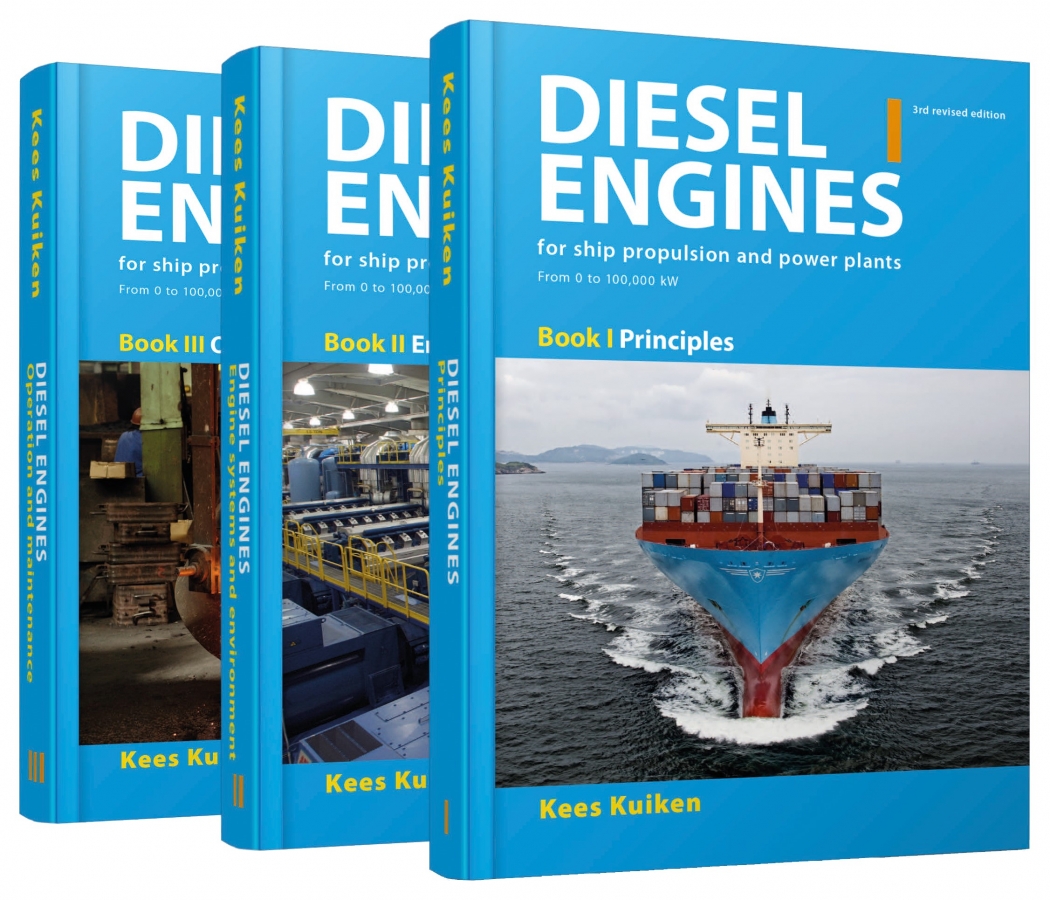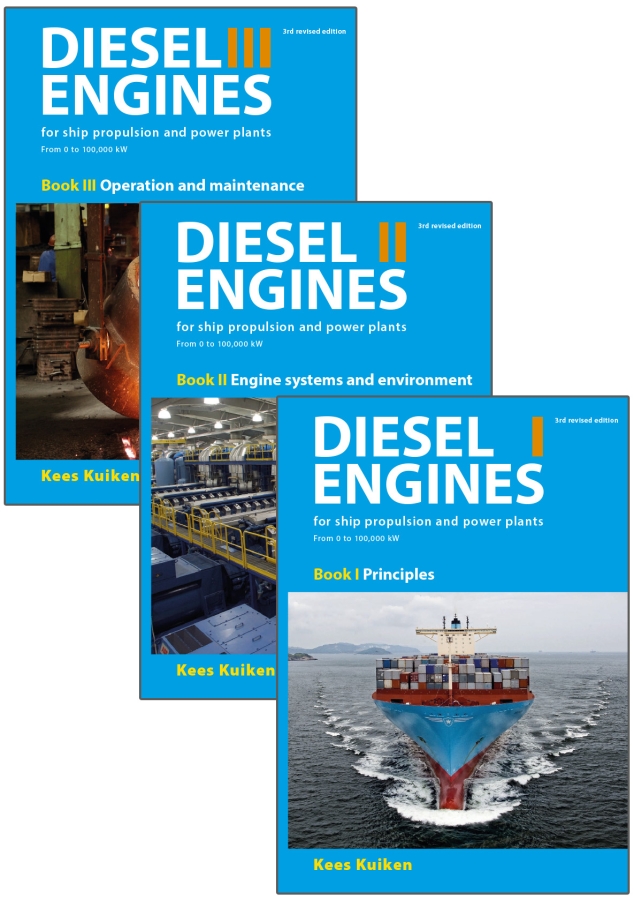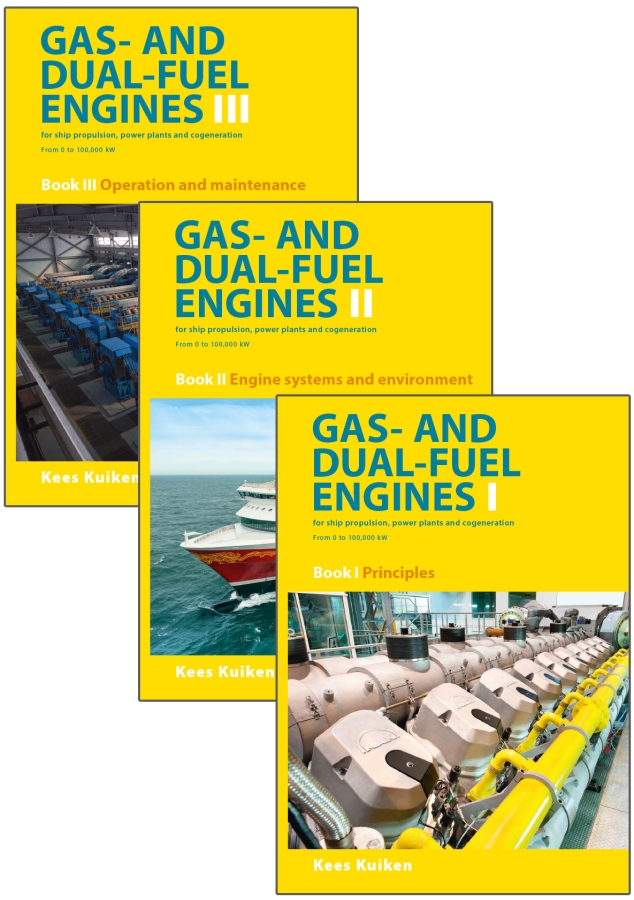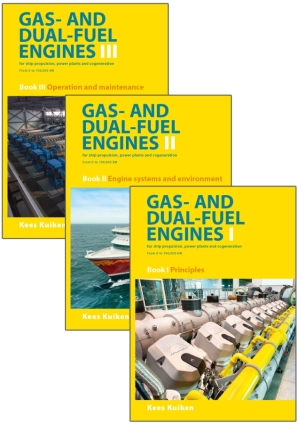E-Book Gas- and Dual-Fuel Engines for Ship Propulsion, Power Plants and Cogeneration from 0 to 100,000 kW
ISBN : BP108233
This first edition of a three-part book on gas- and dual-fuel engines is intended for all who work with gas- and dual-fuel engines for maritime propulsion, power generation and cogeneration:
- Maritime training institutes and maritime universities;
- Maintenance and reconditioning companies;
- Shipping companies deep-sea, inland, towage, dredging and heavy-load cargo;
- Insurance companies, classification bureaus, surveyors;
- Shipping industry suppliers, suppliers of engine parts, fuel and lubricating oil;
- Engine manufacturers and dealers;
- Power Plants;
- Cogeneration.
The three volumes consist of Book I Principles, Book II Engine systems and environment and Book III Operation and maintenance.
Internal combustion engines play an important role in our society; we are to a large extent reliant on them.
After Nikolaus August Otto developed the first four stroke engine or Otto engine in 1867, the production of this mixture compression engine with an ignition source was realised.
Prior to this, the piston steam engine was the only mechanically-driven machine.The invention of the diesel engine in 1897 by Rudolf Christian Karl Diesel produced a distinct revolution in the area of mechanical drives as the efficiency of the Diesel engine was twice that of the Otto engine.
The two principles for internal combustion engines are also still very much in use in the twenty-first century. There is as yet no real alternative for the propulsion of sea-going vessels and for driving electric generators in remote areas and in those countries where no sophisticated electricity grid is present.The internal combustion engine is globally indispensable for road transport, inland shipping, water sports, for electric emergency systems, agriculture, passenger transportation by buses and trains, the oil- and gas industry and many other industries.
Today (2016) fuel consumption and therefore engine efficiency and emission levels play an important role in the use of internal combustion engines encompassing gas-, dual-fuel- and diesel engines.
Engine efficiency has greatly improved since 1867/1897 with today's efficiencies ranging from 45 to 50% for engines in categories III and IV.
Noxious emissions levels (to the environment, where man is a part of) are becoming increasingly restricted.
The use of liquid fuels such as heavy oil and diesel oil is more sophisticated; the cleaning of exhaust gases is increasingly being applied.
Since the discovery of natural gas in the 20th century, the gas engine, widely used since its introduction in 1867, is being constantly developed.
Modern gas engines are generally used in cogeneration, where both electricity and heat are generated. The combined heat and power efficiency can attain 95%.
In recent years, gas engines have gained awareness. In addition to the above mentioned cogeneration, which has been applied for many years, electricity generating land installations are increasingly being employed.
There are also many pilot projects in shipping in which propulsion engine- and gas-engine gensets operate according to the Otto-principle and the Diesel-principle.
The Otto-cycle in these gensets uses 100% gaseous fuel whereas the Diesel-cycle uses up to 99% gaseous fuel and a small amount of liquid fuel for ignition. The latter principle, the dual-fuel system, can also run on 100% liquid fuel. It is for this reason that this system is often employed for shipping.
The great advantage of gas engines are the relatively low emissions of harmful substances, which means that these engine types can also meet increasingly stringent emission regulations now and in the future.
Therefore for certain purposes, the internal combustion engine is still the preferred driving mechanism and will continue to be so in the future.
Experts do not anticipate an effective replacement before 2050. There have always been 'inventors' and they will continue to develop and improve the principle, thus increasing efficiency and decreasing the noxious emissions. This is often no easy matter and from an economic view point, usually not very interesting.
The piston engine operates discontinuously. The combustion process is very short, after which the entire process starts again.
Since the combustion process takes place in a closed cylinder, heat is generated which is then converted into mechanical energy on the piston and subsequently rotational movement of the crankshaft through the connecting-rod mechanism. Therefore fuel must be ignited for each of the combustion processes.
The combustion process requires air, lots of air. The piston engine is actually a flow machine with a discontinuous process.
The gases pass through numerous pipes, valves and chambers at great speeds, a hard-to-design construction.
Combustion efficiency is now 98% to 99%, and therefore has little room for improvement.
The efficiency is the result of the design of the combustion chamber and the inlet- and outlet ducts. The mechanics of the engine with the piston, connecting rod, crankshaft, camshaft and valve movement have also been optimised. Here too, little room for improvement.
Techniques currently improving these characteristics are: common-rail systems, two-stage turbocharging and Miller timing.
It is evident that any development in internal combustion engines progresses slowly.
Successes are obtained mostly by trial and error.
However, there is one given: at present there is no alternative for the internal combustion engine, nor will there be for the next 25 years.
Natural gas is by far the cleanest of all the fossil fuels, with the lowest CO and NOx emissions and almost no other harmful emissions.
Gas engines operating with natural gas have a high efficiency and very low emissions.
They are generally used for cogeneration and the exhaust gases can also be used as CO fertilisation in greenhouse horticulture after cleaning.
Many view natural gas as the essential fuel for energy requirements until the movement to sustainable energy is achieved.
Worldwide, supplies of this relatively clean fossil fuel, natural gas, are sufficient to meet energy demands until at least 2050.
In shipping, both inland navigation and seagoing vessels, natural gas, in a liquid condition stored as LNG, will remain the fuel of choice for the next decades in order to comply with the increasingly stringent requirements concerning noxious emissions.
Therefore, gas- and dual-fuel engines will be deployed worldwide.
This book is intended as a reference guide for all those who, for whatever reason, come into contact with either gas- and/or dual-fuel engines.
The existing book Diesel engines for ship propulsion and power plants will remain available after the publishing of this book.
Kees Kuiken, Onnen, April 2016
Content Listing
Book I - Theoretical principles and construction.
1 Gas-and dual-fuel engines for ship propulsion, powerplants and cogeneration.
2 Classification of gas- and dual-fuel engines.
3 Working principles of gas-, dual-fuel and diesel engines.
4 Efficiencies and losses in gas- and dual-fuel engines.
5 Parameters of gas- and dual-fuel engines.
6 Construction of various types of gas-,dual-fuel and diesel engines.
7 Gaseous and liquid fuels for gas- and dual-fuel engines.
8 Fuel-injection systems for gas-, dual-fuel and diesel engines.
9 Ignition systems for gas- and dual-fuel engines.
10 New technologies for gas- and dual-fuel engines.
11 Speed control of gas-, dual-fuel and diesel engines.
Book II Engine systems and environment.
12 Air supply for gas-, dual-fuel and diesel engines.
13 Cooling of gas-, dual-fuel and diesel engines.
14 Lubrication of gas-, dual-fuel and diesel engines.
15 Starting systems for gas-, dual-fuel and diesel engines.
16 Vibration and balancing of gas-, dual-fuel and diesel engines.
17 Engine noise: origin and damping.
18 Gas- and dual-fuel manufacturers.
19 Emissions of gas-, dual-fuel- and diesel engines.
20 Endoscopy and measurements.
Book III - Operation and maintenance.
21 Use of materials for gas-, dual-fuel and diesel engines.
22 Casting, forging and welding engine parts.
23 Reconditioning and their parts.
24 Maintenance and repair of gas-, dual-fuel and diesel engines.
25 Calculation fuel- and lubricating-oil consumption.
26 Operational management and automation.
27 Cogeneration.
28 Transmission gears, flexible couplings, vibration dampers, shafting and shaft generator drives.
29 Bedplates and engine alignments, gearboxes, shafts, propeller shafts and generators.
30 Regulations for propulsion engines, classification, repair and damage.
31 Ship propulsion.

The new third edition of the diesel engine book is available

"Gas- and dual-fuel engines for ship propulsion, powerplants and cogeneration” Is available

E-Book Diesel Engines for Ship Propulsion and Power Plants from 0 to 100,000 kW - 3rd Revised Edition

E-Book Gas- and Dual-Fuel Engines for Ship Propulsion, Power Plants and Cogeneration from 0 to 100,000 kW
Thank you very much for the sample copies of your second edition which I received on Monday
Sanjeev Sarwal
Marine Engineering , Chief Instructor
I have already purchased from you a copy of Diesel Engines in english some time ago and I would like to compliment you on writing a truly great and very informative book.
Frank Buckley
The book will be used from the 1st semester and by approximately 100 students.
Lars Fors
Engineering Department University of Kalmar , Lecturer





